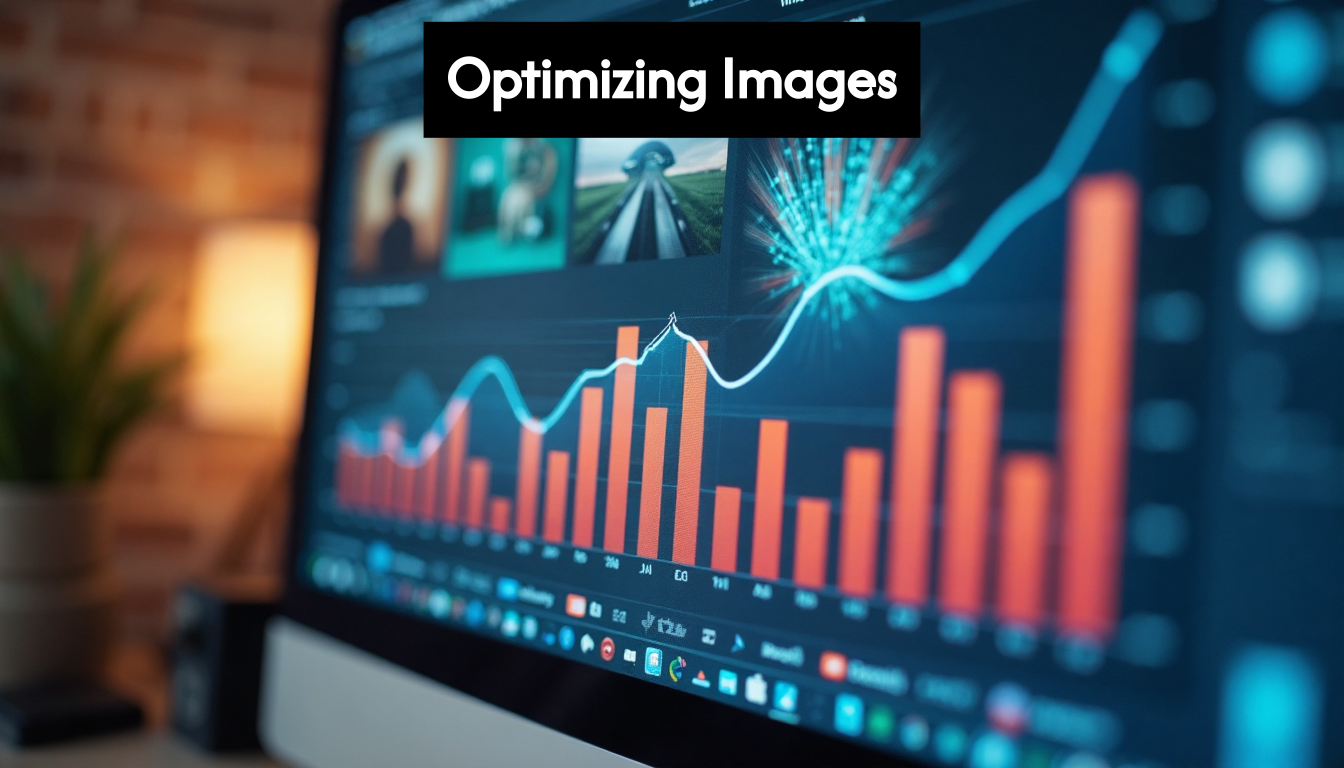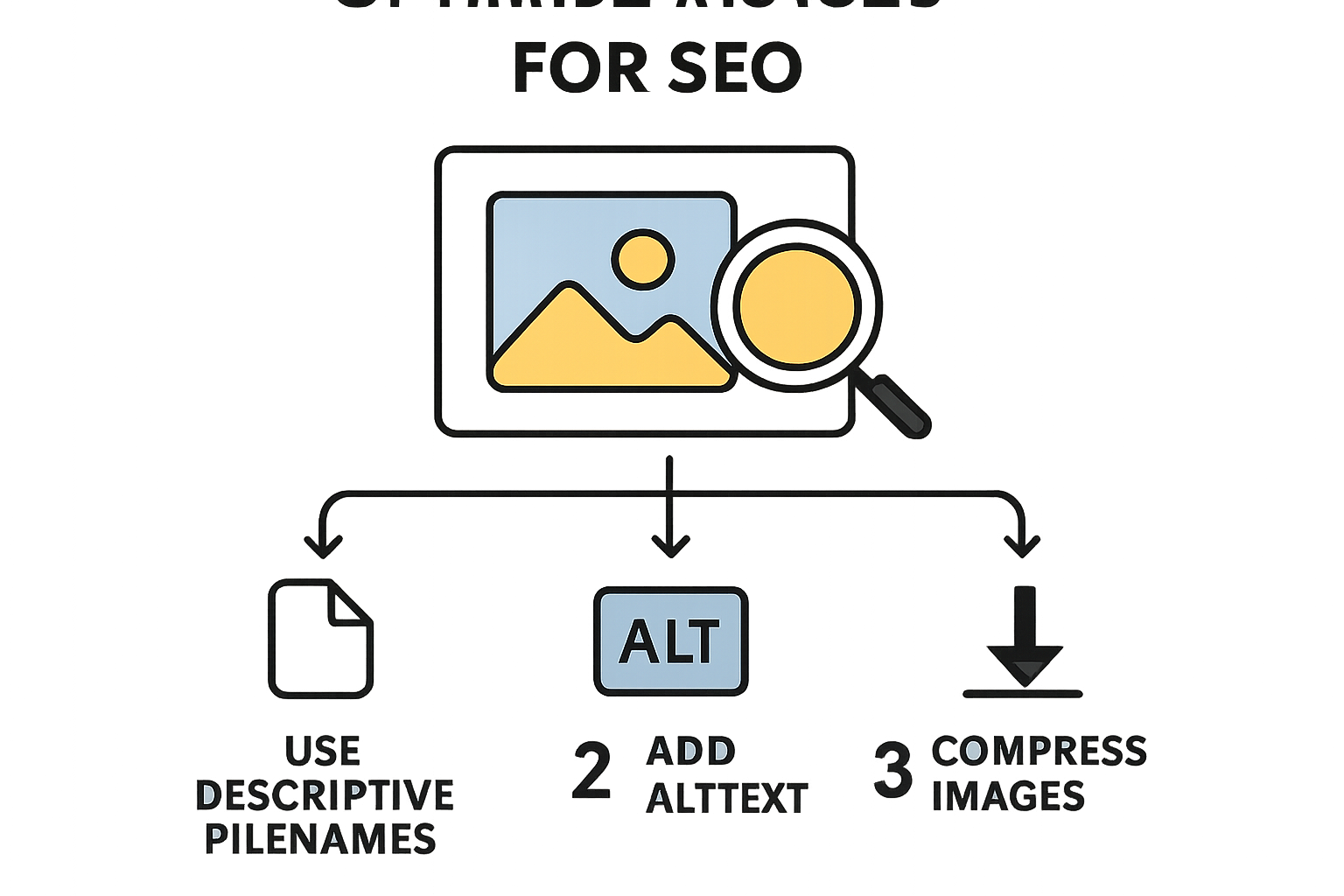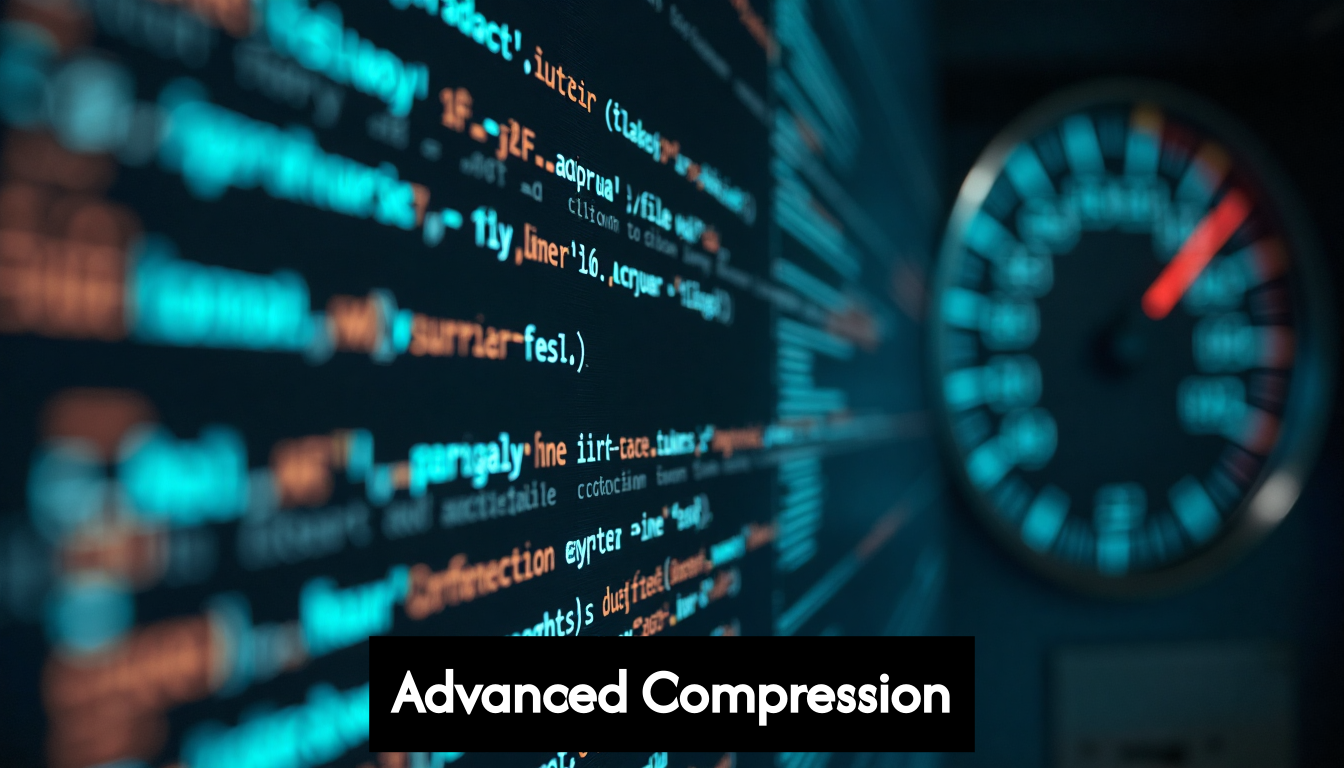Optimizing Images for SEO: Your 2025 Guide


Images play a pivotal role in shaping a website's SEO success. With optimized images boosting search visibility by up to 94%, they are far more than just visual embellishments. Yet, here's the kicker: many businesses overlook the immense potential of image optimization. The truth is, neglecting this aspect can lead to lost traffic and engagement. By prioritizing image optimization, you can enhance user experience, improve accessibility, and significantly increase your organic reach.
Table of Contents
- Why Image Optimization Matters For SEO
- Essential Steps To Optimize Images
- Effective Image Optimization Techniques
- Best Practices For Image SEO
- Strategic Image Selection And Context
- [Technical Optimization And Metadata Strategies](#technical-optimization and Metadata Strategies)
- Performance And Accessibility Considerations
Quick Summary
| Takeaway | Explanation |
|---|---|
| Image Optimization is Crucial for SEO | Properly optimized images significantly enhance website visibility in search results, improve user engagement, and can lead to increased organic traffic by addressing page load speeds and accessibility. |
| Use Appropriate File ForMats and Compression | Selecting the right file formats (e.g., JPEG, PNG, WebP) and employing advanced compression techniques can drastically reduce file sizes while maintaining image quality, optimizing website performance. |
| Implement Descriptive Attributes | Crafting SEO-friendly file names and detailed alt text not only makes images accessible for visually impaired users but also provides search engines with essential context, boosting SEO performance. |
| Adopt Responsive Image Techniques | Utilizing responsive image techniques, such as "srcset", ensures that images adjust according to device specifications, enhancing both load times and user experience across different platforms. |
| Prioritize Contextual and High-Quality Images | Selecting unique, contextually relevant images directly related to content improves SEO performance, signaling to search engines that the visual content is informative and purpose-driven. |
Why Image Optimization Matters for SEO
In the competitive digital landscape, image optimization has become a critical component of successful SEO strategies. Visual content is no longer just an aesthetic choice—it's a powerful tool for improving search engine rankings, user engagement, and overall website performance.
The Search Engine Visibility Connection
Search engines like Google have sophisticated algorithms that analyze images as integral content elements, not just decorative add-ons. Google's official documentation reveals that properly optimized images can dramatically expand your website's visibility in image search results. By implementing strategic optimization techniques, websites can potentially increase their organic traffic and reach a broader audience.
The impact goes beyond mere visibility. Page load speed—significantly influenced by image file sizes and optimization—is a critical ranking factor. Unoptimized images can create substantial performance bottlenecks, causing slower page rendering and potentially driving away users. Research indicates that even a one-second delay in page load time can result in a 7% reduction in conversions, making image optimization a crucial element of both SEO and user experience.
Accessibility and User Experience
Image optimization isn't just about technical performance—it's also about creating an inclusive digital experience. Properly optimized images with descriptive alt text improve website accessibility for visually impaired users who rely on screen readers. This approach aligns with web accessibility guidelines and demonstrates a commitment to providing an equitable online experience.
Moreover, search engines use alt text and image context to understand the content's relevance. By crafting meaningful, keyword-rich descriptions, you're not only helping users but also providing search algorithms with additional context about your content. This dual benefit enhances both SEO performance and user engagement.The Evolving Landscape of Visual Search
The digital marketing landscape is rapidly transforming, with visual content becoming increasingly prominent. Search Engine Land reports that emerging AI-powered search features are integrating visual content more comprehensively, making image optimization more critical than ever. Brands that invest in high-quality, strategically optimized images will be better positioned to capture user attention and improve their search rankings.
Key considerations for effective image optimization include:
- Selecting appropriate file formats (JPEG for photographs, PNG for graphics with transparency)
- Compressing images without sacrificing quality
- Using descriptive, keyword-relevant file names
- Implementing responsive images that adapt to different device screens
- Providing comprehensive, contextual alt text
By treating images as strategic assets rather than mere visual decorations, businesses can unlock significant SEO potential and create more engaging, accessible web experiences.
Essential Steps to Optimize Images
Optimizing images is a strategic process that goes far beyond simply reducing file sizes. For digital marketers and content creators, understanding and implementing comprehensive image optimization techniques can significantly enhance website performance, user experience, and search engine rankings.

Selecting The Right File Format And Compression
Choosing the appropriate file format is the foundational step in image optimization. Different image formats serve different purposes and can dramatically impact your website's performance. Google's web performance guidelines recommend using JPEG for photographic images with complex color variations, PNG for graphics requiring transparency, and WebP as a modern format offering superior compression without quality loss.
Compression is equally critical. Modern image compression tools like TinyPNG and Squoosh allow you to reduce file sizes without perceptible quality degradation. The goal is to find the perfect balance between image clarity and file size, typically aiming to keep images under 200 KB without compromising visual integrity.
Implementing Descriptive And SEO-Friendly Image Attributes
Search engines rely on textual cues to understand image content. Google's Search documentation emphasizes the importance of creating comprehensive, descriptive attributes that provide context. This means crafting meaningful file names that include relevant keywords, writing detailed alt text that accurately describes the image, and using captions that provide additional semantic information.
For example, instead of using a generic filename like "IMG_1234.jpg", rename it to something descriptive like "organic-vegetable-garden-summer-harvest.jpg". Similarly, alt text should be concise yet informative: "Fresh organic vegetables harvested from a sustainable home garden" provides clear context for both users and search algorithms.
Responsive And Technical Image Optimization
In today's multi-device digital ecosystem, images must be responsive and technically optimized. This involves using HTML5 responsive image techniques like the srcset attribute, which allows browsers to select the most appropriate image size based on the user's device screen. Web.dev recommends implementing techniques that serve different image sizes and resolutions to improve loading performance and user experience.
Additionally, consider leveraging modern image formats like WebP and AVIF, which offer superior compression compared to traditional formats. Browser support for these formats has significantly improved, allowing for more efficient image delivery without sacrificing quality.
Practical optimization strategies include:
- Using responsive image techniques with
srcsetandsizesattributes - Implementing lazy loading for images below the fold
- Utilizing browser caching for image assets
- Considering next-generation image formats like WebP and AVIF
- Maintaining a consistent image quality-to-size ratio
By meticulously applying these optimization techniques, websites can create a more performant, accessible, and search-engine-friendly visual experience that delights users and improves overall digital presence.
Effective Image Optimization Techniques
Mastering image optimization requires a strategic approach that combines technical expertise, creative thinking, and an understanding of search engine algorithms. By implementing advanced techniques, digital marketers and content creators can transform images from simple visual elements into powerful SEO assets.
Advanced Compression and Performance Strategies
Beyond basic file size reduction, advanced image compression techniques offer nuanced approaches to maintaining visual quality while minimizing load times. Google's Web Performance Team recommends leveraging next-generation image formats like WebP and AVIF, which provide superior compression compared to traditional JPEG and PNG forMats.
 Modern compression tools now utilize machine learning algorithms to intelligently reduce file sizes without perceptible quality loss. Tools like Squoosh and ImageOptim use advanced techniques that analyze image content, selectively removing unnecessary data while preserving critical visual information. The goal is to achieve the smallest possible file size with minimal visual degradation.
Modern compression tools now utilize machine learning algorithms to intelligently reduce file sizes without perceptible quality loss. Tools like Squoosh and ImageOptim use advanced techniques that analyze image content, selectively removing unnecessary data while preserving critical visual information. The goal is to achieve the smallest possible file size with minimal visual degradation.
Structured Data and Semantic Optimization
Optimizing images goes beyond technical performance—it's about creating meaningful context for search engines. Google's Search documentation emphasizes the importance of structured data and semantic markup to help search algorithms understand image content more comprehensively.
Implementing schema.org markup for images can provide additional context, potentially enabling rich results in image search. This involves adding structured Metadata that describes the image's subject, creator, licensing information, and other relevant details. For example, using ImageObject schema can help search engines understand the image's context, potentially improving its visibility and relevance in search results.
Responsive And Adaptive Image Techniques
The modern web demands images that seamlessly adapt to diverse device ecosystems. Responsive image techniques have evolved to provide more sophisticated solutions beyond simple resizing. Web.dev recommends using advanced HTML5 attributes like srcset and sizes to create truly adaptive image experiences.
These techniques allow browsers to intelligently select the most appropriate image resolution based on device characteristics, screen size, and network conditions. By providing multiple image versions with different sizes and densities, websites can ensure optimal visual quality and performance across smartphones, tablets, desktops, and emerging device types.
Key advanced optimization strategies include:
- Implementing Machine learning-powered compression techniques
- Using next-generation image formats like WebP and AVIF
- Adding comprehensive schema.org structured data
- Creating multiple image resolutions with
srcset - Utilizing adaptive image loading techniques
- Integrating client-side and server-side image optimization methods
By adopting these sophisticated image optimization techniques, digital professionals can create more intelligent, performant, and search-engine-friendly visual experience that enhances both user engagement and organic search visibility.
Best Practices for Image SEO
Navigating the complex landscape of image SEO requires a holistic approach that combines technical optimization, strategic content design, and a deep understanding of search engine algorithms. By implementing comprehensive best practices, digital marketers can transform images from passive visual elements into powerful drivers of organic search performance.
Strategic Image Selection and Context
Google's Search documentation emphasizes that image selection goes far beyond aesthetic appeal. High-quality, original images that directly relate to your content provide significant SEO advantages. This means prioritizing unique, professionally created visuals over generic stock photography.Contextual relevance is paramount. Images should seamlessly integrate with surrounding content, offering visual reinforcement of written information. For instance, an article about gardening techniques should feature original images demonstrating specific planting methods, rather than generic landscape photographs. This approach signals to search algorithms that your visual content is purposeful and informative.
Technical Optimization and Metadata Strategies
Metadata transforms images from mere visual assets into discoverable, indexable content. Search Engine Land reports that comprehensive Metadata can significantly enhance image search visibility. This involves crafting descriptive file names, writing detailed alt text, and implementing structured data Markup.
Consider these Metadata optimization techniques:
- Create file names that are descriptive and keyword-relevant
- Write alt text that accurately describes the image and provides context
- Include captions that Offer additional semantic information
- Implement schema.org structured data for enhanced search understanding
Additionally, ensure images are accessible through a centralized Digital Asset Management (DAM) system and delivered via a Content Delivery Network (CDN) to improve loading speeds and global accessibility.
Performance and Accessibility Considerations
Image SEO extends beyond technical optimization into performance and inclusivity. Web Accessibility Guidelines highlight the importance of creating images that are not only search-engine friendly but also accessible to users with diverse needs.
This means:
- Providing meaningful alternative text for screen readers
- Ensuring color contrast meets accessibility standards
- Creating images that are Legible across different devices and screen sizes
- Implementing lazy Loading to improve page performance
- Using responsive image techniques that adapt to various display contexts
By treating images as strategic content assets—not just decorative elements—digital professionals can create a more inclusive, performant, and search-engine-optimized visual experience. The key is viewing image optimization as an ongoing process of refinement, continuously adapting to evolving search algorithms and user expectations.
Frequently Asked Questions
What is image optimization for SEO?
Image optimization for SEO involves techniques used to reduce image file sizes and ensure their proper formatting, which helps improve website performance, search visibility, and user experience.
Why is image optimization important for search engines?
Image optimization is crucial because search engines analyze images as part of their algorithms. Properly optimized images can enhance search visibility, improve page load speeds, and increase organic traffic.
How can I optimize images for better SEO performance?
To optimize images, use appropriate file formats (JPEG, PNG, WebP), implement descriptive alt text, apply advanced compression techniques, and utilize responsive image techniques like srcset.
What role does alt text play in image optimization?
Alt text provides context for images, making them accessible for visually impaired users and helping search engines understand the image's relevance, which can improve SEO performance.
Elevate Your SEO Game with Smart Image Optimization
Are you struggling to harness the full power of image optimization as highlighted in our guide, "Optimizing Images for SEO: Your 2025 Guide"? Images can significantly boost your search visibility, yet many businesses miss out due to improper techniques. Don’t let unoptimized images hinder your website’s performance any longer. What if there was an effortless way to generate SEO-friendly content while ensuring your visuals are top-notch?

With BabyLoveGrowth.ai, you can transform your SEO strategy today! Our platform not only automates content generation but also provides an in-depth business analysis that targets your specific challenges. Imagine a tailored 30-day content plan that includes optimized image strategies—boosting your visibility, engagement, and organic traffic effortlessly. Ready to take that pivotal step?
Join us now at babylovegrowth.ai and see your business rise above the competition!
Recommended Articles
- Understanding Nofollow Backlink: What You Need to Know for SEO Success
- What is Website Optimization? Your Simple Guide to Boost Site Performance
- SEO for Manufacturers That Work: Boost Your Online Presence
- Off Page SEO Meaning: Unlock Your Search Authority
- SEO for Restaurants: Simple Strategies to Boost Your Business
Smart SEO,
Faster Growth!
Most Read Articles

Generative Engine Optimization (GEO)
Learn how Generative Engine Optimization (GEO) helps your content rank in AI search engines like ChatGPT and Google AI. This comprehensive guide explains the differences between SEO and GEO, why it matters for your business, and practical steps to implement GEO strategies for better visibility in AI-generated responses.

Track LLM Traffic in Google Analytics 4 (GA4)
Learn how to track and analyze traffic from AI sources like ChatGPT, Claude, Perplexity, and Google Gemini in Google Analytics 4. This step-by-step guide shows you how to set up custom filters to monitor AI-driven traffic and make data-driven decisions for your content strategy.

How to Humanize AI Text with Instructions
Learn practical techniques to make AI-generated content sound more natural and human. This guide covers active voice, direct addressing, concise writing, and other proven strategies to transform robotic text into engaging content.

Open AI Revenue and Statistics (2024)
Comprehensive analysis of OpenAI financial performance, user engagement, and market position in 2023. Discover key statistics including $20B valuation, $1B projected revenue, and 100M+ monthly active users.